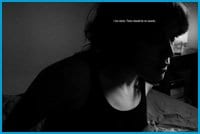
SUSPECT. By Patricia Rozema.
Adam Garnet Jones and Jamie Travis can’t figure out why they’ve never met. The two twentysomething filmmakers are both queer, both from British Columbia and have both screened at and attended a bunch of film festivals at the same time. Their paths might finally cross at the Toronto International Film Festival (TIFF) this year. Jones is premiering his new piece Cloudbreaker as part of the Short Cuts Canada Program and Travis is featured in the same program with his new piece The Saddest Boy In The World. Though stylistically very different, both pieces explore eerily similar issues of isolation and depression in preteen boys.
Jones and Travis even have a handful of friends in common including actress/producer Amy Belling. One of Travis’s past collaborators, Belling was the star of Jones’s first piece ever, an angsty little teen suicide video called Past Tense. A 14-year-old girl develops a coke addiction and has to deal with an unplanned pregnancy after both her parents die, all in under five minutes. “It was a little over the top,” laughs Jones. “Amy was good, but the piece was pretty awful.” He’s quick to add the flick wasn’t based on personal experiences. “It was the ’90s and teen suicide was in the media a lot,” he says. “It was just a really sexy topic.”
Jones shot the piece at the age of 14 at the Gulf Islands Film School, in Victoria, BC. Despite his family not having much money, coming up with the tuition fee wasn’t much of a problem. “We’d just moved to Victoria and I didn’t have any friends, which made it easy to not spend money,” he says. “I had a small allowance and there was nothing to spend money on besides pop and candy, so I was able to save it up.”
Travis is equally embarrassed about his first outing with a camera — a high-school book report called Books ‘N’ Stuff on the topic of “the roots of evil.”
“It was just this other guy and I talking about books we hadn’t read,” says Travis, laughing. Embarrassing as it might be now, that outing was a turning point. “After that any time there was a chance to do a school project on video I leapt at it,” he says.
After high school, the two went on fairly divergent paths with Jones attending the Emily Carr Institute for film and Travis enrolling at the University Of British Columbia as a biochemistry major. A few months into their studies, both had the standard first-year-student existential crisis and decided they were heading in the wrong direction.
For Jones it wasn’t so much his studies he was unhappy with, as the city he was living in. “I realized that the community I wanted didn’t exist in Vancouver,” he says. “Toronto had the kind of filmmaking community and the kind of queer community I needed at that point in my life.” After about five minutes of deliberation, he decided to pack it all up and book a one-way ticket to the Big Smoke.
Travis also lost speed halfway through his first year, but for totally different reasons. “In high school I was a total book-smart science nerd,” he laughs. “I didn’t really have any friends. I was totally consumed by school and there wasn’t a need for much else.”
As often happens, nookie won out over knowledge and his life focus took a dramatic shift when he met his first boyfriend. “My coming out as gay coincided with seeing my entire education as a sham,” he says. “It was the first time I was consumed by something other than school. I realized I was unhappy and I had to think about my direction in life.”
Like Jones, he decided to hop on a plane for a summer in Europe. “This will sound totally stereotypical, but it was a real journey of discovery,” he laughs. Obviously something changed, because when he came back to Vancouver, he shot a new piece of work and landed a slot in film school.
***
The last four years have been busy for Jones. In addition to attending the film program at Ryerson, he’s been working for a bunch of organizations including LIFT, Inside Out and ImagineNative.
His graduating film Cloudbreaker tells the story of a 10-year-old native boy named Darron who’s struggling with issues of culture and identity. It opens with our protagonist writing the childhood equivalent of a Dear John letter to his mom in preparation for his planned disappearance. Darron’s not orchestrating a typical childhood runaway, though. He’s starting preparations on a magic ceremony that will turn him into a wolf.
“It’s really not a piece about escaping an unhappy life,” Jones stresses, “so much as it’s about gaining strength by embracing cultural signifiers.”
In similar style, Travis also premiered his graduating film from UBC Film School at TIFF in 2003, a piece called Why The Anderson Children Didn’t Come To Dinner which he describes as a prequel this year’s piece, The Saddest Boy In The World.
Saddest Boy opens with the ninth birthday party of Timothy, the film’s rather tragic hero. Not usually the place you’d start a film about depression, but for Travis the decision was automatic. “Birthdays have a very traumatic connotation for me,” he says. “I associate them with incredible sadness.
“My mother thought it would be a novelty for both of her children to have the same birthday,” he says. “So she scheduled her caesarean section for me on the same day my older sister was born a few years earlier. Always being forced to share my birthday with my sister robbed it of any specialness for me.”
Both artists are quick to stress that their pieces are not autobiographical, though clearly very personal. “It’s not a literal retelling of something that happened to me, but there are definitely aspects of my life in there,” Jones says. “I was raised by a single parent and I spent a lot of time alone growing up. I was obsessed with magic and ideas of transformation. I actually did have the pieces of a magic recipe to turn me into a wolf, but I was afraid to try it.”
Jones confesses to several years of depression through his childhood, periods of feeling suicidal. “There were a lot of things that made me feel separate and alienated; my sexuality, the fact I was of mixed race, our economic status,” he says. “These things made me feel apart at times, but they also made me feel strong and exceptional at others.”
Travis has a similar take on his film. “If anything, it’s a hugely exaggerated account of my childhood experiences,” he says. “I was pretty melodramatic kid so it makes sense that I would see my childhood that way now.”
Depending on the viewer’s predilections, Saddest Boy also has a strong queer undertone, though Travis stresses it wasn’t conceived that way. “A lot of my films are recognizably gay, whether I intend it or not,” he says. “When we were designing this piece, we kept finding props with rainbows on them for some reason. The visual aesthetic of the piece just kept getting gayer and gayer.”
It’s hard to believe anything in Travis’s work is accidental. In all of his films every square inch of the frame is precisely and perfectly planned. Travis is getting a mini showcase at TIFF. His shorts Patterns 2 and Patterns 3 are also screening (in a different program). Combining animation, musical elements and a sense of foreboding, these two shorts best exemplify Travis’s fascination with visual design.
“Many people would say I’m a control freak when it comes to design,” he laughs. “My scripts are all highly dictated by the spaces they occur in so nothing can be left to chance. I’m sure there are people who can do a better job than I can, but I haven’t found them yet.”
Despite this, Travis’s next project, an unnamed suspense-thriller, is a departure from his current style. “I’m trying to move into a more plot-driven less arty style of filmmaking,” he says. “I’m feeling more confident with my ability to work with actors and I want to make something that will appeal to a wider audience.”
While Jones is also interested in expanding his art to include other aspects of film, video and installation, he seems pretty content with his style of work for the moment. “I remember working on the first shot of the film when Darron looks up at the clouds and tries to get them to move. In that moment my whole life started to fold in on itself,” he says. “Looking at this kid who looks exactly like me at that age doing something that I did — I realized I was telling a story that was important.”


 Why you can trust Xtra
Why you can trust Xtra


